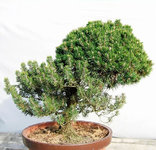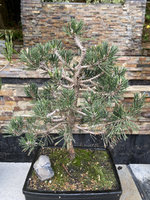You are using an out of date browser. It may not display this or other websites correctly.
You should upgrade or use an alternative browser.
You should upgrade or use an alternative browser.
Graft wound identification on JBP?
- Thread starter TheBlackBonsai
- Start date
mwar15
Omono
Buy a JBP without a graft, you will be better off in the long run
TheBlackBonsai
Seedling
I have a few without grafts, just wanted to know about this one in particular. Thank you for your comment.Buy a JBP without a graft, you will be better off in the long run
Deep Sea Diver
Masterpiece
Yep, it’s grafted.
See the inverted V on the trunk, above which the bark changes to more of a gnarly texture? That’s a saddle graft.
There’s not much you can do with it as is. It’s front and center. So be sure the front is 90 degrees from the V.
Successful Air layers on JBP’s are few and far between.
That said, it’s a great tree to practice on! While doing so, check around there are some great JBP starter trees out there, or search around and look for something about 8 years old you can work into something really good.
cheers
DSD sends
See the inverted V on the trunk, above which the bark changes to more of a gnarly texture? That’s a saddle graft.
There’s not much you can do with it as is. It’s front and center. So be sure the front is 90 degrees from the V.
Successful Air layers on JBP’s are few and far between.
That said, it’s a great tree to practice on! While doing so, check around there are some great JBP starter trees out there, or search around and look for something about 8 years old you can work into something really good.
cheers
DSD sends
vancehanna
Chumono
Check the Naka book on approach grafting a series of seedlings right at the graft junction. A lengthy process and very time consuming.
memwar is right, buy one with a better and lower graft. Or better yet no graft at all. Buy seedlings or mature 5 yrs olds.
memwar is right, buy one with a better and lower graft. Or better yet no graft at all. Buy seedlings or mature 5 yrs olds.
Shibui
Imperial Masterpiece
Pines can be layered. Older trunks can take some time and don't always produce roots but younger wood is usually reliable and relatively quick. Layering at or just above the graft will solve the problem once and for all.
Is this really JBP? bark does not look like black pine and the needles I can see are quite short for black pine. The root stock appears to be some other species too. Most black pines seem to be grafted onto black pine stock but maybe over there you have more choices and someone has found a different compatible root stock for the JBP cultivars.
Is this really JBP? bark does not look like black pine and the needles I can see are quite short for black pine. The root stock appears to be some other species too. Most black pines seem to be grafted onto black pine stock but maybe over there you have more choices and someone has found a different compatible root stock for the JBP cultivars.
HardBall
Yamadori
Looks like Kotobuki to me.
Deep Sea Diver
Masterpiece
TheBlackBonsai
Seedling
Thank you all for the knowledge! I’m taking this tree on as a practice project because I have a JBP that I'm really in love with but I don’t want to make too many noob mistakes on it. I thought this would be a perfect guinea pig, that is until I received it and noticed the graft. Bummer but that’s what I get for buying online.
Not a total waste though, I’d like to learn layering and how to get this thing on its own roots. @Shibui I had your same thought about the tree not being JBP, it just doesn’t look like my others and has lots of madness going on near the needles that my other JBPs don’t seem to have. Geez….
Not a total waste though, I’d like to learn layering and how to get this thing on its own roots. @Shibui I had your same thought about the tree not being JBP, it just doesn’t look like my others and has lots of madness going on near the needles that my other JBPs don’t seem to have. Geez….
Bonsai Nut
Nuttier than your average Nut
As @HardBall said above, that appears to be a kotobuki - a JBP dwarf cultivar with very short (and stiff) dark green needles. It looks pretty different from standard JBP... but otherwise care is the same. I have one and think it is pretty cool in its own way. Yatsubusa is a dwarf cultivar that was created from a witches broom on a kotobuki.I had your same thought about the tree not being JBP, it just doesn’t look like my others and has lots of madness going on near the needles that my other JBPs don’t seem to have. Geez….

Here's the original tree that is the source for all Yatsubusa JBP. You can see the kotobuki needles on the lower branches - and the lighter green yatsubusa needles on the top witches broom.
ShadyStump
Imperial Masterpiece
I was just wondering about this.The root stock appears to be some other species too. Most black pines seem to be grafted onto black pine stock but maybe over there you have more choices and someone has found a different compatible root stock for the JBP cultivars.
If you can identify the rootstock, it may potentially be conducive to air layering. Then you could layer it right below the graft, and hide the bulge in the nebari.
TheBlackBonsai
Seedling
It’s totally Kotobuki! Can’t believe the photo you have provided in your last post is the source for ALL Yatsubusa JBPs that’s so awesome and pretty neat.As @HardBall said above, that appears to be a kotobuki -
Here is the Kotobuki up against a few of my other JBPs. I’m going to attempt layering right above the graft point most likely Novemberish. Is this okay? Fingers crossed
Attachments
Bonsai Nut
Nuttier than your average Nut
I have actually never tried a JBP air-layer, so I wish you luck. I have heard they are quite difficult. Make sure you the proper rooting hormone concentration (high).I’m going to attempt layering right above the graft point most likely Novemberish. Is this okay? Fingers crossed
Crazy Diamond
Omono
Ive seen people air layering JBP but only young very vigorous branches not old trunks, he can try root grafting with young pines above the sweling
ShadyStump
Imperial Masterpiece
Stumbled across this thread recently.
 www.bonsainut.com
Could a similar technique be used to generate roots for ground layering it maybe? Perhaps right after a repot when the existing roots have been trimmed back, maybe in stages to slowly work the roots up the trunk.
www.bonsainut.com
Could a similar technique be used to generate roots for ground layering it maybe? Perhaps right after a repot when the existing roots have been trimmed back, maybe in stages to slowly work the roots up the trunk.
Cutting bark to promote new growth?
Hi, pretty new to bonsai. I was watching a Heron's bonsai vid, and he mentions just placing cuts in bark to promote new leaf or branch growth. Is this actually possible? I haven't seen it discussed on the forum, that or I'm not sure of the correct name for it.
AcerAddict
Shohin
Not to hijack this thread, but how are Kotobuki JBP for bonsai in terms of ease of care? They're compatible with my zone, and I have an opportunity to get one in a 1 gallon nursery pot for $50.
Similar threads
- Replies
- 17
- Views
- 2K
- Replies
- 15
- Views
- 368



